| Description | Participants | Summaries | Products |
|---|
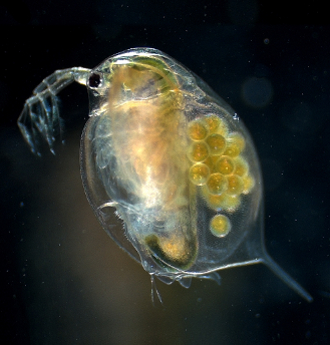
NIMBioS Working Group
Modeling Molecules-to-Organisms
Topic: Dynamic models to link molecular perturbations to individual impacts for ecological risk assessment of chemicalsMeeting dates: Nov. 16–20, 2015; Apr. 18–21, 2016; Nov. 29-Dec. 2, 2016; Sep 12-15, 2017
Organizers:
Cheryl A. Murphy, Fisheries and Wildlife, Lyman Briggs College, Michigan State Univ.
Roger Nisbet, Ecology, Evolution, and Marine Biology, Univ. of California at Santa Barbara
Objectives: In ecotoxicology research, two approaches have been gathering support because of how each tackles problems related to risk assessment. One is the adverse outcome pathway (AOP) framework, which links molecular initiating events to adverse outcomes at higher levels of biological organization. The second approach is dynamic energy budget (DEB) modeling, which employs a mechanistic approach to determining allocation of energy to growth and reproduction and that can be applied to multiple species. Furthermore, DEBs have been embedded into individual-based models (IBMs), allowing for extrapolation to population impacts. This working group will bring together a multi-disciplinary group of molecular biologists, systems biologists, DEB and AOP modelers, ecotoxicologists and mathematicians with interest and expertise in developing dynamic, mechanistic models to predict impacts on individuals from high throughput assays used to screen chemicals for potential risk. The working group will use a case study approach to demonstrate proof of concept and will aim to develop, not only example models, but a general framework for model development, evaluation, and communication that can be applied across different levels of biological organization and ecotoxicological endpoints relevant to the individual. The working group will closely coordinate with the working group on Modeling Organisms-to-Ecosystems chaired by Valery Forbes and Christopher Salice, using the same case study species (i.e. daphnids and trout), with the intent to develop a modeling framework that ultimately can link from molecular responses (AOPs) through whole organism responses to ecosystem service delivery.
Ideas for this working group benefited from discussions at the NIMBioS Investigative Workshop on Predictive Models for Ecological Risk Assessment.
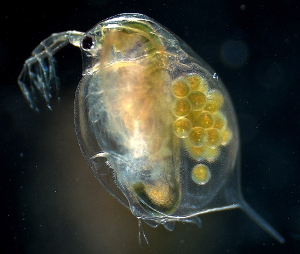
Meeting Summaries
| Mtg # | Dates | Agenda | Summary | Photo | Evaluation |
|---|---|---|---|---|---|
| 1 | Nov 16-20, 2015 | Link | Link | Report | |
| 2 | Apr 18-21, 2016 | Link | Link | ||
| 3 | Nov 29-Dec 2, 2016 | Link | Link | ||
| 4 | Sep 12-15, 2017 | Link | Link |
Meeting 1 Summary. The first meeting was scheduled simultaneously with the NIMBioS Working Group: Modeling Organisms to Ecosystems. The two groups had a short plenary meeting at least once each day with all remaining spent working as separate groups. The first two days were devoted to discussion organized around informal presentations on the approaches currently used by participants. Topics included methodology for synthesizing "-omics" data, detailed dynamic models of specific AOPs, systems models of organ response to stressors, and parameter estimation for DEB models. By the end of day two, there was a tentative conceptual model for future work. During the first two days, there was also discussion about the use of data from organisms other than rainbow trout and Daphnia, e.g. model organisms used in toxicology, such as fathead minnow and zebrafish, and from human health studies, such as human mortality linked to acetaminophen. Much of the work during the third and fourth days was performed in two subgroups, one identifying ways of integrating molecular information to inform organ or DEB dynamics, the other working on models linking the dynamics within organs to DEB dynamics. Each group defined a program of work to be completed before the second meeting in April 2016.
Meeting 2 Summary. The Working Group first defined the content of two publications that describe the approach of the group to relating suborganismal data on response to stress with organismal responses, as well as a set of presentations for upcoming conferences. For much of the meeting, the group continued to work in the two subgroups that were created at the first meeting. The first group addresses ways to relate information on changes in gene expression in response to stress to the variables and parameters used in dynamic energy budget (DEB) models. The second group focuses on adapting the standard DEB formalism in ways that will permit integrating it with more detailed information on sub-organismal processes relating to reproduction. Between meetings, many members of the subgroups continued to work together. At the second meeting, the first subgroup designed in detail a new set of experiments involving measurements on stressed Daphnia at both molecular and organismal level. Participants involved in the experimentation and modeling activities will include an instructor and undergraduates at a four-year college, working in collaboration with Working Group members from two US government laboratories, three US universities and three European universities. Between meetings, two members of the second subgroup adapted the mathematical structure of the standard DEB model in a way that would permit connections with submodels describing hormonal dynamics and the effects of endocrine disruptors. At the meeting, the second subgroup developed methodology that will allow the new DEB model configuration to be tested on data from a US national laboratory characterizing the effects of endocrine disruptors on rainbow trout. If successful, the approach could be extended to take advantage of promising data sets from other sources for trout, lake trout, fathead minnow and killifish that are available. Near the end of the meeting, there was a plenary discussion of questions on DEB modeling raised by the sister NIMBioS Working Group on Modeling Organisms-to-Ecosystems, and a response was sent.
Meeting 3 Summary. TBA
Meeting 4 Summary. TBA
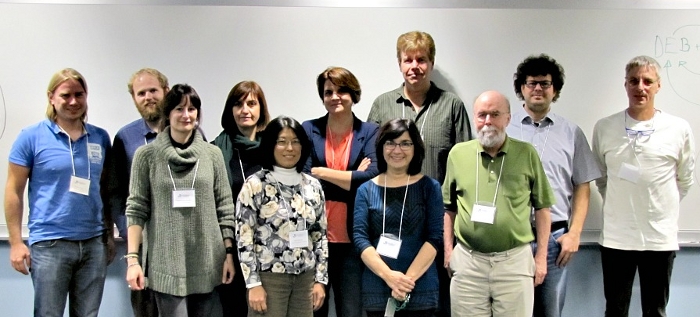 |
| Mtg. 1 participants (L to R): Philipp Antczak, Chris Remien, Natalia Garcia-Reyero, Konstadia (Dina) Lika, Karen Watanabe, Cheryl Murphy, Diane Nacci, Irv Schultz, Roger Nisbet, Andre Gergs, Erik Muller. |
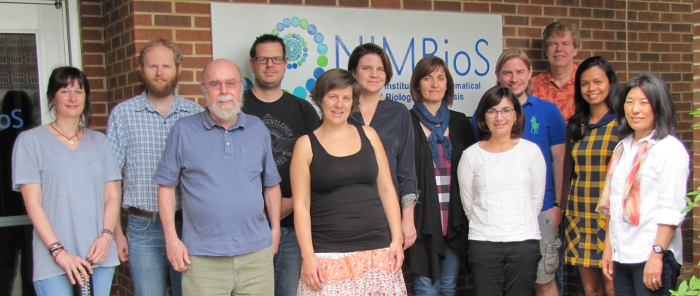 |
| Mtg. 2 participants (L to R): Natalia Garcia-Reyero, Chris Remien, Roger Nisbet, Andre Gergs, Angie Peace, Cheryl Murphy, Konstadia (Dina) Lika, Diane Nacci, Philipp Antczak, Irv Schultz, Teresa (Terry) Mathews, Karen Watanabe. |
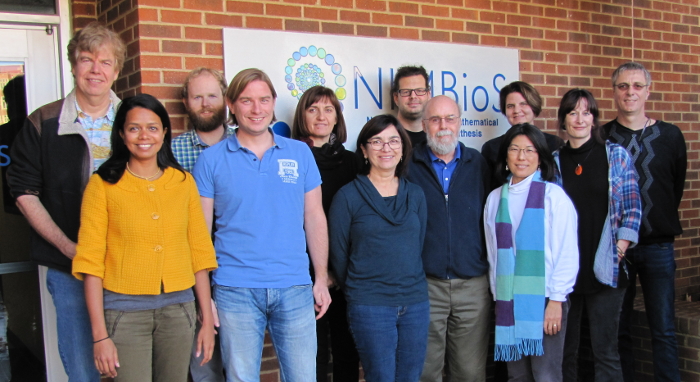 |
| Mtg. 3 participants (L to R): Irv Schultz, Teresa Matthews, Chris Remien, Philipp Antczak, Konstadia (Dina) Lika, Diane Nacci, Andre Gergs, Roger Nisbet, Karen Watanabe, Cheryl Murphy, Natalia Garcia-Reyero, Erik Muller. |
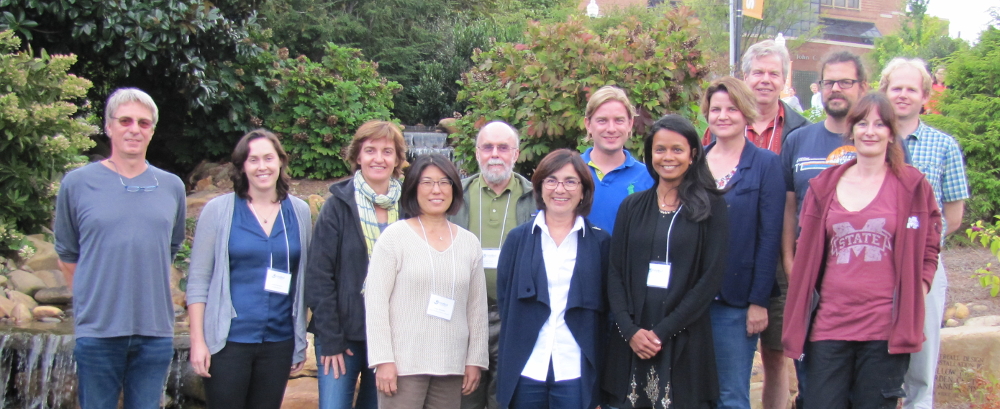 |
| Mtg. 4 participants (L to R): Erik Muller, Louise Stevenson, Konstadia (Dina) Lika, Karen Watanabe, Roger Nisbet, Diane Nacci, Philipp Antczak, Teresa Matthews, Cheryl Murphy, Irv Schulz, Andre Gergs, Natalia Garcia-Reyero, Christopher Remien |
 |
| Combined Meeting 4 participants, Molecules-to-Organisms and Organisms-to-Ecosystems Working Groups |
NIMBioS Working Groups are chosen to focus on major scientific questions at the interface between biology and mathematics. NIMBioS is particularly interested in questions that integrate diverse fields, require synthesis at multiple scales, and/or make use of or require development of new mathematical/computational approaches. NIMBioS Working Groups are relatively small (up to 10 participants), focus on a well-defined topic, and have well-defined goals and metrics of success. Working Groups will meet up to 3 times over a two-year period, with each meeting lasting up to 2.5 days.
A goal of NIMBioS is to enhance the cadre of researchers capable of interdisciplinary efforts across mathematics and biology. As part of this goal, NIMBioS is committed to promoting diversity in all its activities. Diversity is considered in all its aspects, social and scientific, including gender, ethnicity, scientific field, career stage, geography and type of home institution. Questions regarding diversity issues should be directed to diversity@nimbios.org. You can read more about our Diversity Plan on our NIMBioS Policies web page. The NIMBioS building is fully handicapped accessible.
NIMBioS
1122 Volunteer Blvd., Suite 106
University of Tennessee
Knoxville,
TN 37996-3410
PH: (865) 974-9334
FAX: (865) 974-9461
Contact NIMBioS


